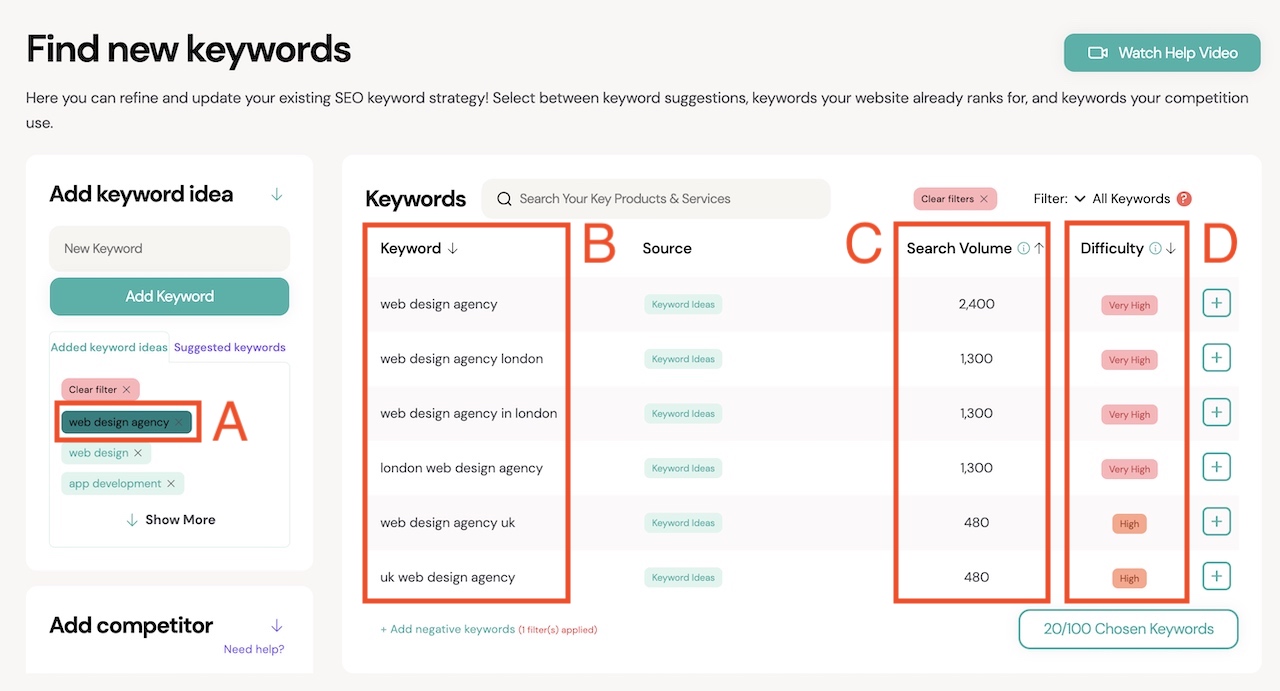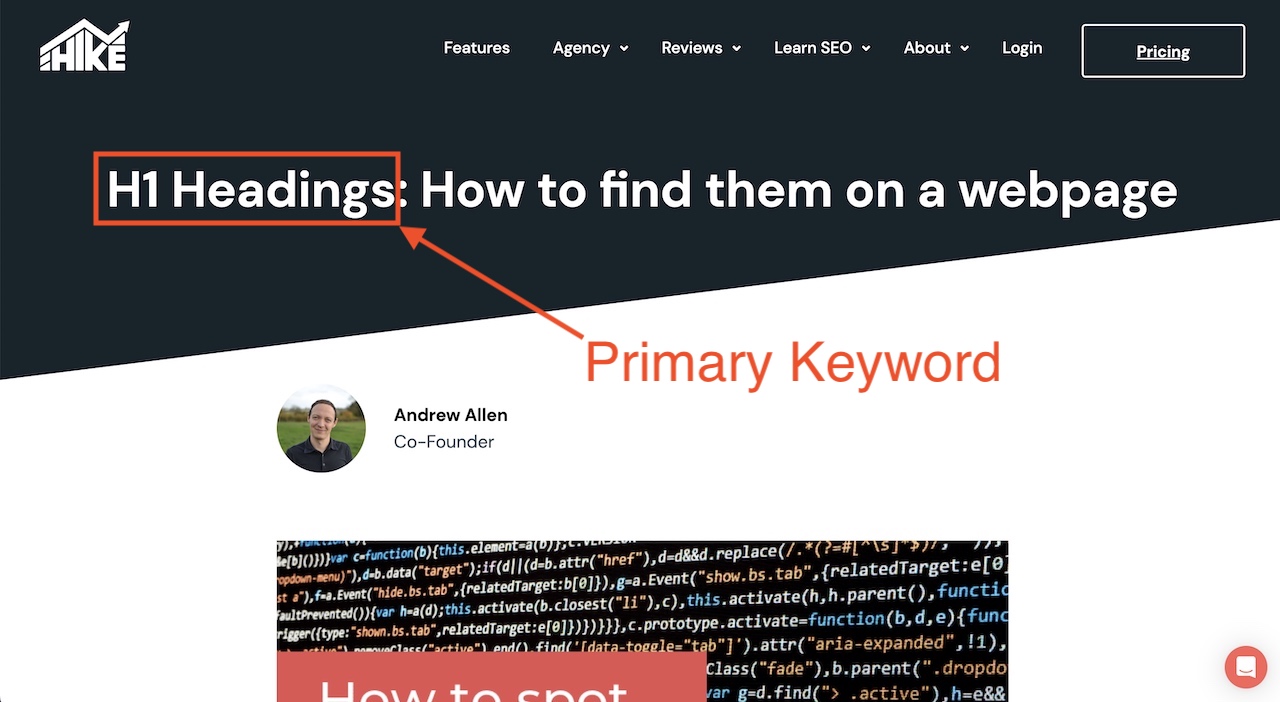Keyword Research Tips - Keyword Strategy for Beginners
What is Keyword Research?
Keyword research is the process of identifying and analyzing the words and phrases (known as keywords, keyword phrases, or search terms) that people use when searching for information, products, or services on search engines like Google, Bing, or Yahoo. The main objective of keyword research is to determine which keywords are relevant and valuable for a particular website or online business, to optimize the site's content, and to increase its visibility in search engine results pages (SERPs).
Below, you can seen the keyword research tool in Hike, starting with (A) the seed keyword to generate (B) the keyword ideas, and then you can see how much (C) search volume and (D) difficulty score there is to prioritize them.

Why is Keyword Research Important?
Keywords are the bread and butter of what people use to find what they are looking for in search engines, although today, it’s common for people to use their voice or images to search. In those cases, their voice or images are converted into text search phrases for the search engine to process. Below are some reasons why doing keyword research is important for SEO:
Understanding Your Audience
Keyword research helps you identify the terms your target audience is using to search for information, products, or services. By understanding the language they use, you can create content that better resonates with their needs and preferences, but more importantly, you get to understand your audience’s needs at a deeper level, allowing you to refine your offering to better serve and add value to them.
Relevance & Targeting
By targeting the right keywords, you can ensure that your content is relevant to your audience and meets their search intent. This increases the likelihood that search engines will rank your website higher in the search results, leading to increased organic traffic. When your content is relevant and aligned with your audience, then they are less likely to leave your website and more likely to engage with your content and other pages on your website, possibly resulting in converting them into a customer.
Competition Analysis
Keyword research allows you to evaluate the competition for specific keywords. By identifying high-value, low-competition keywords, you can optimize your content to rank higher in search results and differentiate your website from competitors. Understanding how many people on average per month are searching for a specific topic, and knowing in advance how difficult it will be to rank for that keyword automatically sets the priorities for your content strategy, so you can focus on the low-hanging fruit and succeed faster than without these insights.
Content Creation and Optimisation
Keyword research helps you identify content gaps and opportunities based on what your target audience is searching for. This helps you create valuable, relevant, and engaging content that meets the needs of your audience and aligns with search engine requirements. It gives you a map to start building your content strategy, making it much easier to plan your content with the time and resources you have available.
Improved Search Engine Rankings
It’s important to note that content should always be created for people first, and not for search engines. However, optimizing a page for a specific keyword, makes it more relevant for the reader, which improves their experience. By incorporating the right keywords into your website's content, meta tags, and other on-page SEO elements, you can improve your website's visibility on search engine results pages (SERPs). Of course, other factors come into play, but along with this, it leads to higher rankings, increased organic traffic, and better chances of attracting potential customers or clients.
Resource Allocation and ROI
Finally, keyword research helps you prioritize your SEO efforts and allocate your resources more effectively. By focusing on high-value keywords that are likely to generate traffic, leads, or sales, you can maximize the return on investment (ROI) of your SEO and content marketing efforts. Then through keyword rank tracking and traffic & conversion analysis, you can see exactly how your SEO drives business growth.
The Three Pillars of Keyword Research
There are three primary pillars to consider when doing keyword research – relevance, search volume, and difficulty score. These pillars are essential components to consider when identifying and prioritizing keywords for your website or online business. These factors help you determine which keywords are most likely to drive organic traffic, improve search engine rankings, and support the success of your SEO strategy. Let’s explore each of these in more detail:
Keyword Relevance
Relevance refers to how closely a keyword aligns with your website's content, products, or services. When selecting keywords, it's crucial to ensure that they are highly relevant to your target audience and their search intent. Relevant keywords allow you to create content that addresses the needs and interests of your audience, improving user engagement (decreasing bounce rates) and increasing the likelihood of conversions. Additionally, search engines prioritize content that is relevant to users' queries, so targeting relevant keywords can lead to higher search engine rankings.
For example, on one of Hike's blog articles, "H1 Headings" is the primary keyword for this article, which is highly relevant to the focus topic, which is talking about H1 headings and doesn't deviate from it.

Keyword Search Volume
Search volume represents the average number of times a keyword is searched for on search engines within a given timeframe, usually per month. High search volume indicates that many people are interested in that topic or searching for related products or services. Targeting keywords with higher search volume can increase the potential organic traffic to your website. However, it's essential to balance search volume with relevance and competition, as high-volume keywords often have more competition and may not always be the most relevant to your specific niche or business.
Keyword Difficulty Score
The difficulty score, also known as keyword competition or keyword difficulty, is a metric that estimates how challenging it would be to rank for a specific keyword on search engine results pages (SERPs). This score usually ranges from 0 to 100, with higher scores indicating more competitive keywords. Difficulty scores consider various factors, such as the number of competing websites targeting the same keyword, the quality of their content, and their page authority / domain authority. When selecting keywords, it's generally recommended to target those with lower difficulty scores, as they may offer a better chance of ranking higher in search results.
Bonus: Keyword Value
The value of a keyword can be subjective, but a great indication of how valuable it is in your market or industry is to look at the cost per click (CPC) value or bid value that search advertisers are currently paying. The higher advertisers are willing to bid to get a click on their ad that is displayed for a specific keyword, the more they value it and the more profitable it is for them, otherwise they would stop advertising if it didn’t bring them business to cover the cost of acquiring a customer. Keywords with higher bid values could have high commercial value, so it’s also important to consider this metric when prioritizing your keywords.
The Keyword Research Process
Just like many things in SEO, there is a specific process to follow that will help you to choose the best keywords for your business. Below are a few steps that we recommend you follow when doing keyword research, for maximum results:
Choose Seed Keywords
The first step is to make a list of seed keywords to start from. Seed keywords are the keyword topics that you use to generate additional keyword ideas from using keyword research tools. These are starting points and come from your knowledge of the industry, your audience, products, services, and other topics that are relevant to your business.
Jot down as many as you can down on a spreadsheet or document, as you’ll be going through each one to generate further keyword ideas in the next step.
Generate Keywords
The next step is to use the seed keywords to generate additional keyword ideas and the data that goes with those keywords, such as search volume and difficulty score. You’ll need to use a keyword research tool like one within Hike SEO and enter your seed phrases.
The software will then generate a list of additional keywords that are related to that seed keyword. Your task is to go through that list and shortlist and save all of the relevant keywords. Remember, this is not the stage of being too selective, so just focus on relevance first. You’ll filter out later. Repeat for each of the seed keywords. Sometimes, you’ll discover additional seed keywords within those keyword ideas that you can use to generate more keywords from. Keep going until you have an exhaustive list of keywords to start narrowing down from.
Filtering
Now that you have your keywords, it’s time to sort and filter out the keywords that are a good balance between relevance, search volume, and difficulty, in that order of importance.
You can specify a cutoff for difficulty score, for example, 40/100 where you won’t consider keywords that are beyond that. Don’t throw them away, but you could keep them on a separate list for the future.
You can also specify a cutoff for search volume, for example, a minimum of 100 searches per month. Again, keep the ones that don’t meet the requirements in a separate list for future use.
You should now have a shortlist of relevant keywords, and have a reasonable search volume and difficulty score that’s achievable to compete against.
Clustering
The next step is to cluster your keywords into topic groups. This will allow you to see which keywords deserve their dedicated page, and which ones can be grouped into the same page.
In this step, you would group keywords by closely related topics. If the keyword you’re considering doesn’t fit an existing topic close enough, then create a new group. This is best done on a spreadsheet where you can have headings and sections for each group.
Clustering also gives structure and hierarchy to your keywords so it makes the content planning and website page structuring easier later on.
Prioritizing
Once you’ve clustered your keywords into logical groupings, the final stage is to prioritize them based on your business needs as well as how valuable the keywords are.
For example, you might prioritize content that uses keywords relating to your products or services first, then move on to industry topics and then common questions.
Another option is prioritizing content based on how easy it is to rank for the keywords and their search volume potential.
There’s no right or wrong method here, it depends on which type of prioritization you’d like to use, and then sort your keyword clusters into the order you’ll use them to create content around.
Hike + Keyword Research
If you’re looking for a simple keyword research tool, look no further than Hike SEO. This platform is built from the ground up with small businesses in mind, making it easy and quick for them to discover relevant keywords and start using them on their website.
Using cutting-edge AI, Hike recommends the best keywords for your business, cutting down on the time you would have to spend researching and filtering keywords. In short, it makes SEO a breeze, even if you have no prior experience or technical knowledge.
Give Hike a try today risk-free, with a 14-day money-back guarantee.